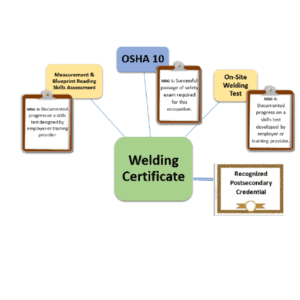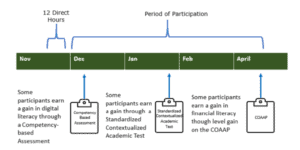A WIOA Career Pathway Promise Fulfilled (sort of)
May 11th, 2021 | Blogs
A January 2021 update to federal adult education performance accountability has opened up new ways to document learning in Integrated Education & Training and workplace education programs and new ways to show the impact of our work to our communities and other stakeholders.
Hard to believe, but the Workforce Innovation and Opportunity Act (WIOA) – the federal law that authorizes the public adult education system – is being teed up for reauthorization talks this spring. Years ago, as practitioners worked to develop and implement effective adult career pathways that leverage adult education and workforce development career and training services, we frequently told our federal partners at the U.S. Departments of Education & Labor that they were making our work IMPOSSIBLY difficult because our systems were aiming at different targets. We had performance accountability policies working against student success.
WIOA’s passage in 2014 brought the promise of shared accountability to the partners with the definition of six core outcomes, including five different interim progress metrics to document progress along the way to the achievement of recognized postsecondary credentials and quality employment. However, subsequent WIOA regulation for Title II continued adult education’s laser focus on the National Reporting System (NRS) pre/post-testing for Education Function Level gain.
During this past year, the COVID-19 requirement to move to remote teaching and learning revealed the house of cards our federal accountability is based on. Without the use of one of the very few NRS approved tests, practitioners were stymied to even enroll adult learners. Remote test proctoring stories were often nightmarish – a young mother 5 hours into an online exam taken in her bedroom closet is interrupted by her toddler needing a diaper change and is told her test and her time and her effort are invalidated – and made us ashamed.
While we continue to imagine into existence our perfect adult education accountability system, at least we now have additional options for demonstrating skill gain within a couple of program models:
IET is a small but growing part of WIOA adult education, and the now allowable use of Measurable Skill Gain (MSG) type 4 Training Milestone and MSG type 5 Skills Progression to document MSG on NRS table 4 (the NRS table used in negotiated performance target setting between US ED and the state AEFLA agency and – hence – the state agency and AEFLA local grantees) means a state and local program can finally get credit for the learning that happens along the way to a recognized postsecondary credential.

Here’s how a local program might design a welding IET program to document these MSGs and the recognized postsecondary credential. [Note that the credential outcome is not an MSG but is a separate outcome measure that can be taken during program participation or up to one year after exit.
Workplace education and literacy programs, like those at Tyson Upward Academy, that partner with AEFLA funded adult education are providing clear guidance to their state partners through guidance documents like that created by Anson Green, Economic Opportunity Director in Tyson’s Corporate Social Responsibility division and former Texas Adult Education State Director.

The Tyson example above notes a variety of MSG opportunities for a participant in an onsite ESL class. Note how digital literacy skill gains are recorded through competency-based assessments; standardized contextualized academic exams (non-NRS approved) are another possibility for documenting skills; as are financial literacy gains measured via the CASAS additional assessment rubrics. This holistic approach to documenting – and therefore investing time, talent, and resources in – these critical skills truly honors the adult learner in all their roles as worker, family member, and community member.
There is a lot of work ahead for state adult education funders to ‘turn on’ these additional measures through explicit guidance and technical assistance to local providers. The expanded reporting is available to use this program year, opening an opportunity to perhaps capture all the remarkable digital skills adult learners gained during remote learning in these two program models and required next program year.
One step closer to shared accountability, these small but significant changes should make it easier to co-enroll and truly partner with our WIOA Title I youth and adult partners and with employers to provide comprehensive, human-centered services to support adults in building foundational skills and more.
_________________________________________________
Written by Judy Mortrude. Judy has been an adult education teacher, administrator, state program director, and national policy analyst. Judy currently supports World Education’s NCTN Center of Expertise
World Education fosters enduring partnerships across regions and sectors to advance education outcomes for all. We offer education systems strengthening, program design and implementation, applied research and evaluation, capacity development, and policy development services.